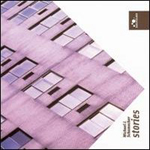|
|
 |
Dusted Reviews
Artist: Michael J. Schumacher Album: Stories Label: Quecksilber Review date: Feb. 10, 2005 |

|
|
|
 |
Stories seeps into your consciousness like a well-designed piece of furniture. At first you realize its presence in the room, but until you sit in it, you don't realize its exquisite detail and thoughtful construction. As an active member of such sound installation galleries as his own Gallery Studio Five Beekman, LaMonte Young’s Dream House and Diapason, sound artist Michael J. Schumacher specializes in creating music that hovers at the edge of perception and becomes part of your space rather than just something to which one listens. He admits to wanting to create music that goes beyond the concert hall. But Stories is not Satie’s Furniture Music – the pieces are too rich in timbre to be mere aural decoration – nor are they ambient in an Eno-esque way, for Schumacher prefers writhing pointillist attacks.
The pieces here are abstract, open-ended explorations of tone and texture, built up from layers of acoustic and digitally generated sounds. Conventional rhythms, harmonies and structural development are absent, and in their place Schumacher weaves a restless counterpoint. ”Still” simmers as a stream of glitch and static, the near-tactile surface punctured by violin and cello squiggles, and echoing bass smears, an electric rainforest alive with chattering creatures. “Pulse” strikes a similar unsettling balance between organic and electronic tones. Flowing MIDI grand piano contrasts sharply with a tiny, needling tone that sounds like a marble being rolled about in a metal tube. An occasional voice, raspy and tattered, speaking an unintelligible language, heightens the otherness.
Aside from the piano on “Pulse,” acoustic instruments exist merely as sound sources, their traditional uses usurped by the extremely abbreviated lengths of individual tones. “Two, Three and Four Part Inventions” and “Room Pieces New York” utilize the full range of instrumental color, from human voice, jagged strings, woodwinds and skittering percussion to gurgling synths and dustings of static. The mix is entirely democratic, no sound or musical gesture more important than any other.
Schumacher’s sound pieces resemble, in their distant mood and juxtaposition of flashes of activity with moments of stasis, early electro-acoustic music, especially Stockhausen’s Kontakte. But unlike those meticulously constructed works, Schumacher generates his pieces on a laptop with random processes. He removes the hand of the composer, making Stories feel soulless in parts, as if all human presence is absent. In other words, Schumacher succeeds. It’s not the musicians or the composer, but the room in which it is played that gives Stories its soul.
By Matthew Wuethrich
|







